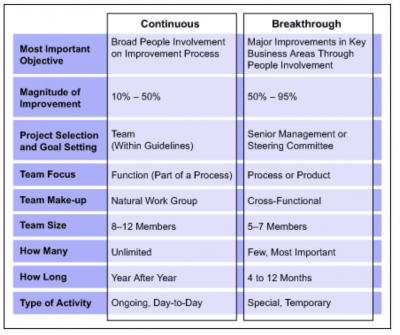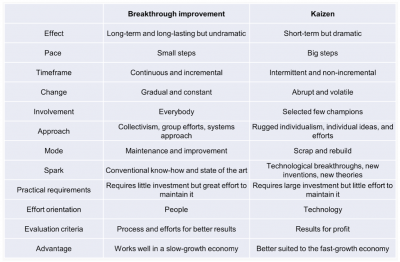
Key Points
- Breakthrough improvements are major changes enacted upon a process or service.
- These are long-term projects that can take up a vast amount of resources.
- There is an inherent risk posed by focusing entirely on a breakthrough improvement.
This article will explore the difference between continuous improvement and breakthrough improvement. We will describe the benefits and best practices of breakthrough improvement and why your organization should set the bar high for achieving breakthrough improvement.
What Is Breakthrough Improvement?
Continuous improvement is about many small incremental improvements. Breakthrough improvement involves major improvements in key business areas. These are often ongoing, long-term problems that can only be solved through focused, dedicated resources working for a limited period. Due to the investment in time and resources, breakthrough improvement projects are typically selected by a management group. A breakthrough improvement goal is expected to be 70% or more.
Continuous improvement is often done by Six Sigma Yellow Belts and White Belts trained in the basic DMAIC method and tools. Black Belts and Master Black Belts are involved in breakthrough improvements. Green Belts can be involved in both types of improvement approaches. Design for Six Sigma projects are typically aiming for breakthroughs.
Below is a table contrasting continuous improvement with breakthrough improvement.

Continuous vs Breakthrough Improvement
How It Differs from Kaizen
Breakthrough improvement projects are generally more complex, longer in duration, and require more in-depth study by a larger, more diverse team. Incremental improvement is usually achieved through the use of Kaizen events. The tables below contrast the two approaches.
|
Breakthrough Improvement |
Kaizen |
| Creativity | Adaptability |
| Individualism | Teamwork (systems approach) |
| Specialist-orientation | Generalist-orientation |
| Attention to great leaps | Attention to details |
| Technology-oriented | People-oriented |
| Information: closed, proprietary | Information: open, shared |
| Functional (specialist) orientation | Cross-functional orientation |
| Seek new technology | Build on existing technology |
| Line + staff | Cross-functional organization |
| Limited feedback | Comprehensive feedback |
Breakthrough improvement vs Kaizen
Comparing the columns above, you can make the following contrasts between breakthrough improvement and incremental or continuous improvement achieved using Kaizen:
- Breakthrough improvement encourages creativity due to its result-oriented mindset and push for dramatic changes.
- Kaizen encourages adaptability and teamwork due to its process-oriented mindset, which necessitates the ability to change and cooperate.
- Breakthrough improvement focuses on a specialist and technology-oriented approach as opposed to Kaizen’s holistic, cross-functional, and people-oriented approach.
- Breakthrough improvement tends to have closed information and constantly seeks new technology allowing for dramatic improvements.
- Kaizens use open-source or shared information while attempting to innovate or build on the current technology at hand.
- Breakthrough improvement can obtain feedback, but at a limited rate due to the large changes this strategy calls for, while Kaizen strategies can regularly gather feedback because small changes can be made through the process.
The following table describes the different characteristics of both the breakthrough improvement approach and the Kaizen approach to incremental improvement.

Characteristics of Breakthrough Improvement vs Kaizen
Breakthrough Improvement vs. Kaizen Summarized
These differences can be summarized as follows:
- Breakthrough improvement tends to have immediate short-term benefits as opposed to a steady and long-lasting effect. This approach to improvement will achieve large steps in improvement that necessitate an intermittent and inconsistent timeframe.
- In the Kaizen approach, small steps are taken, and the timeline is consistent, which results in gradual and constant change.
- The distinct characteristics are aligned with the breakthrough improvement strategy’s result-oriented mindset and the Kaizen strategy’s process-oriented mindset.
While both of these approaches focus on improvement, there is a clear difference illustrated. Kaizen is more about the incremental changes that result in changes. A breakthrough improvement, conversely, is an abrupt gear shift toward a stated goal. Further, they have different economic needs, with a breakthrough improvement best suited for a slower market.
Benefits and Drawbacks of Breakthrough Improvement

©Ground Picture/Shutterstock.com
Breakthrough improvement is designed to achieve significant results when compared to continuous improvement approaches. This will bring benefits to your organization, but there are some drawbacks as well.
Can Deliver New Processes Faster Than Incremental Improvement
Breakthrough improvement stresses new approaches, technology, innovation, and dramatic change. The focus on achieving significant improvement will result in quantum leaps in product and process design.
Requires Greater Time and Resources
Many projects designed for breakthrough improvement will be longer in duration and will require greater investment in technology and resources. However, the eventual level of improvement should make this approach worth the effort.
Greater Risk
Continuous improvement relies on a step-by-step incremental improvement of current processes. Breakthrough improvements, if implemented, carry more risk and difficulty if the improvements don’t work out as planned.
Why Is Breakthrough Improvement Important to Understand
Many organizations are experienced in the methods and tools for continuous improvement such as DMAIC and DMEDI. Since there is less experience with breakthrough improvement strategies, it is important to understand some of the differences.
The Expectation of 70% or More Improvement
There is a commonly accepted expectation for breakthrough improvement of 70% or better. This stretch goal can be challenging.
Necessary Requirements
Since the outcome of a breakthrough improvement project entails more complex and intensive efforts, you should understand the time and people commitment needed to achieve your breakthrough improvement goals.
70% Improvement May Not Be Attainable
Don’t be upset if your goal is to improve by 75%, but despite your best efforts, you only get 60%. 60% is still pretty good and certainly better than the level of improvement you might have achieved using a simpler incremental approach.
An Industry Example

The new CFO of a consumer products company liked to go to Gemba at the different manufacturing sites to see what was happening. He learned one of the largest plants had experienced more batch failures than plants of similar size and product mix. Everyone in the plant had their ideas as to why it was happening, but nothing had improved over the past five years.
The company had just kicked off a rapid continuous improvement effort based on Lean Six Sigma. Incremental improvements had not solved the problem, so the CFO suggested the company try a breakthrough improvement approach to solve this chronic production problem.
A team consisting of a quality manager, a Master Black Belt, a cross-functional team of equipment operators, and process engineers began by closely analyzing the data that had been collected over the years and during previous improvement efforts.
The Aftermath
The analysis led to interesting insights and outcomes. Taking a closer look at the data on batch failures, the operators commented there were a number of problems in product consistency occurring at the same time there were changes in raw material batches. Also, the team found the rejected batches had more than the expected amounts of flavor additive. Finally, the team concluded that the process of mixing flavor additives was one of the root causes of rejections.
The team made some recommendations to develop and implement simple process changes for mixing in flavor additives as well as working with the raw material suppliers to be sure they were providing a consistent product.
The company succeeded in reducing batch failures from a yearly average of 120 to 12 for a 90% breakthrough improvement. By approaching the problems with fact-based analytical tools, the company improved the process generating net improvements worth approximately $1,450,000 of products that could now be sold and not rejected.
Best Practices
Likely, your organization is already familiar with how to do continuous improvement. Here are a few tips to help navigate the process of breakthrough improvement.
Make Sure Breakthrough Improvement Is the Right Approach
Given the increased complexity of breakthrough improvement, be sure it is appropriate for the issue at hand.
Recruit the Best Team Members You Can Get
Projects geared for breakthrough improvement will require greater knowledge and the ability to commit to a longer duration. Be selective in who you choose as team members.
Leadership Commitment
Your leadership must be committed to supporting the team’s efforts and the concept of a longer, more complex project. Don’t let their impatience detract from the longer-term goal of achieving substantial improvement.
Other Useful Tools and Concepts
When improving any process or service, you need to keep an eye on various metrics. Process capability analysis is one method that takes a closer look at measurements like Cp, Cpk, Pp, and Ppk. By close and careful analysis of these metrics, you can quantify just how well the process is improving.
Further, you might need to account for random variation in your data. You can think of this as the noise in a signal-to-noise ratio. Understanding how to account for random chaos in your processes can lead to vast improvements with the right steps taken.
Conclusion
A culture of continuous improvement will engage and empower people to make continuous and incremental improvements in their process.
At times, you will want to achieve more significant improvements. Breakthrough improvement will result in improvement levels of over 70%. But, remember these types of projects will require more time and resources and carry a greater risk.
An organization with a culture of change and improvement will have a balance of both incremental and breakthrough projects.